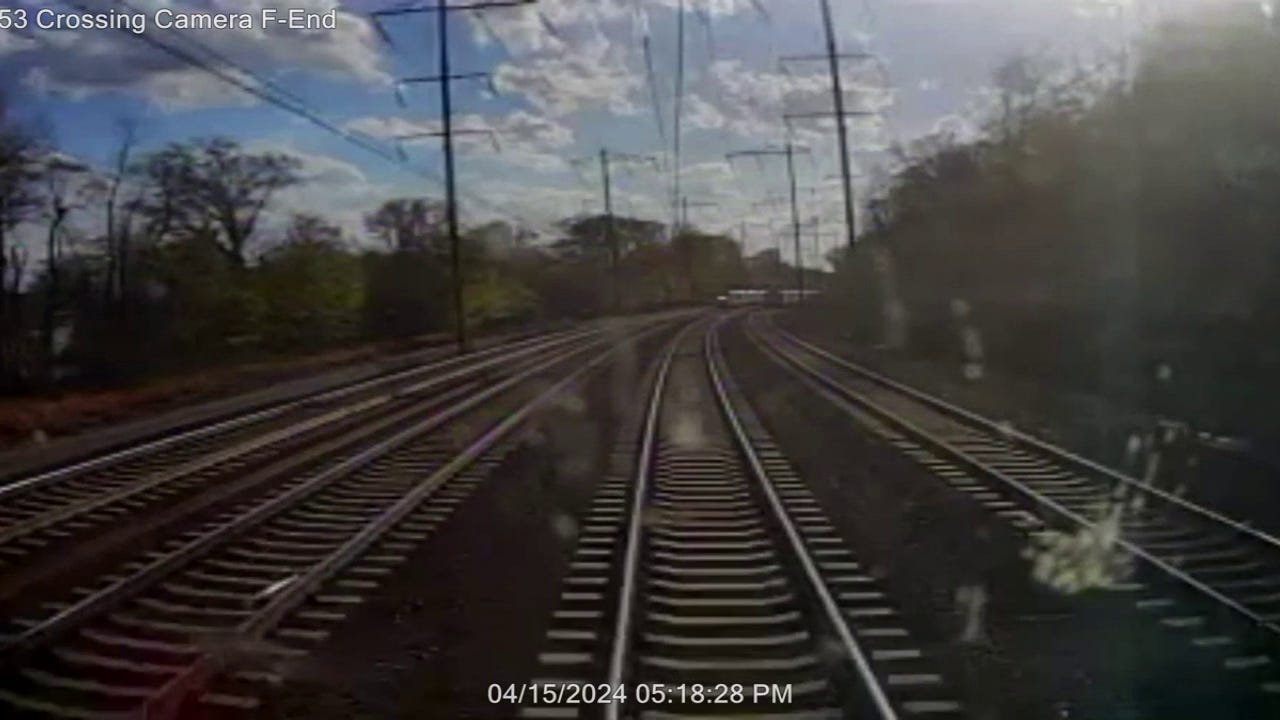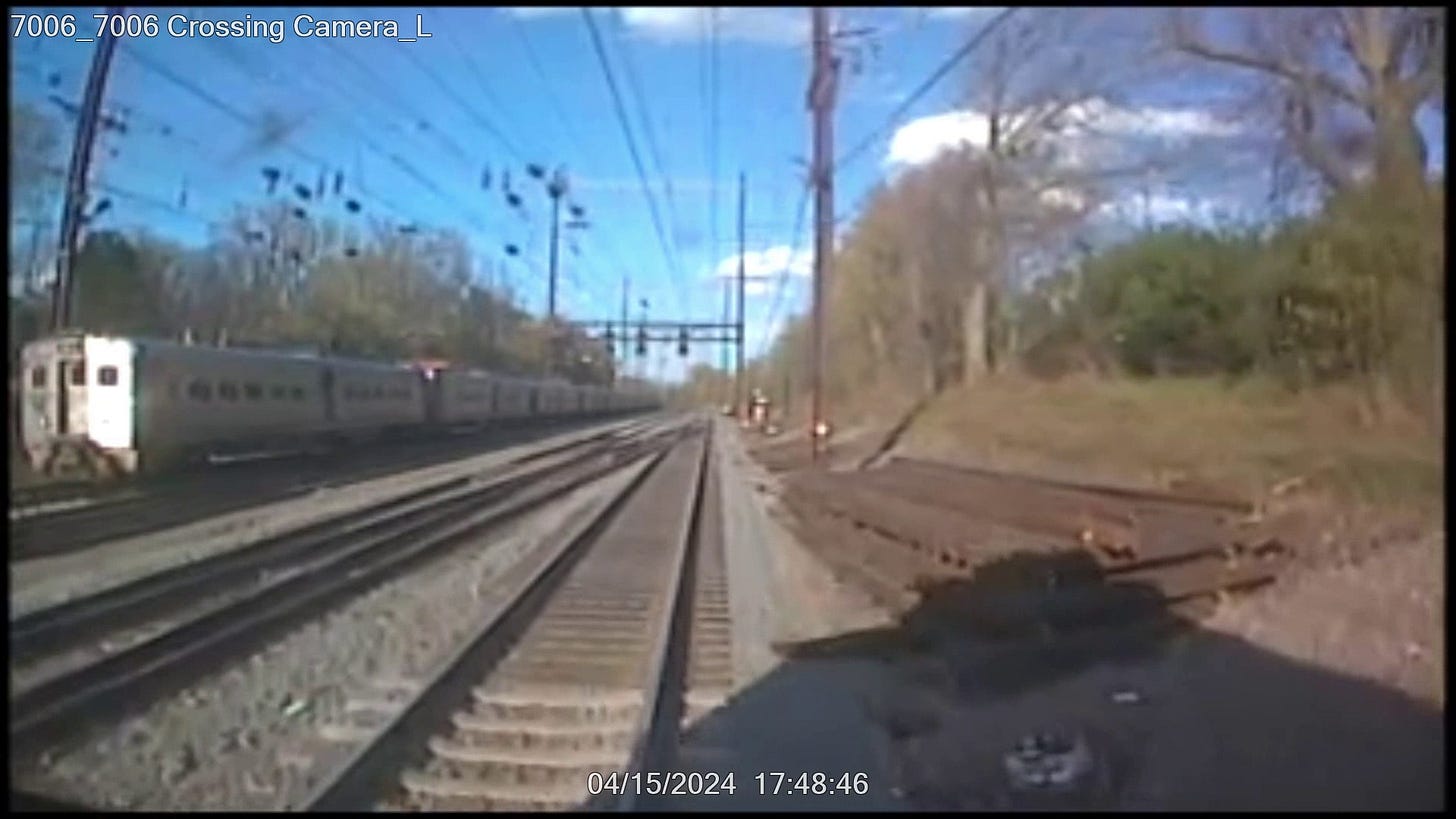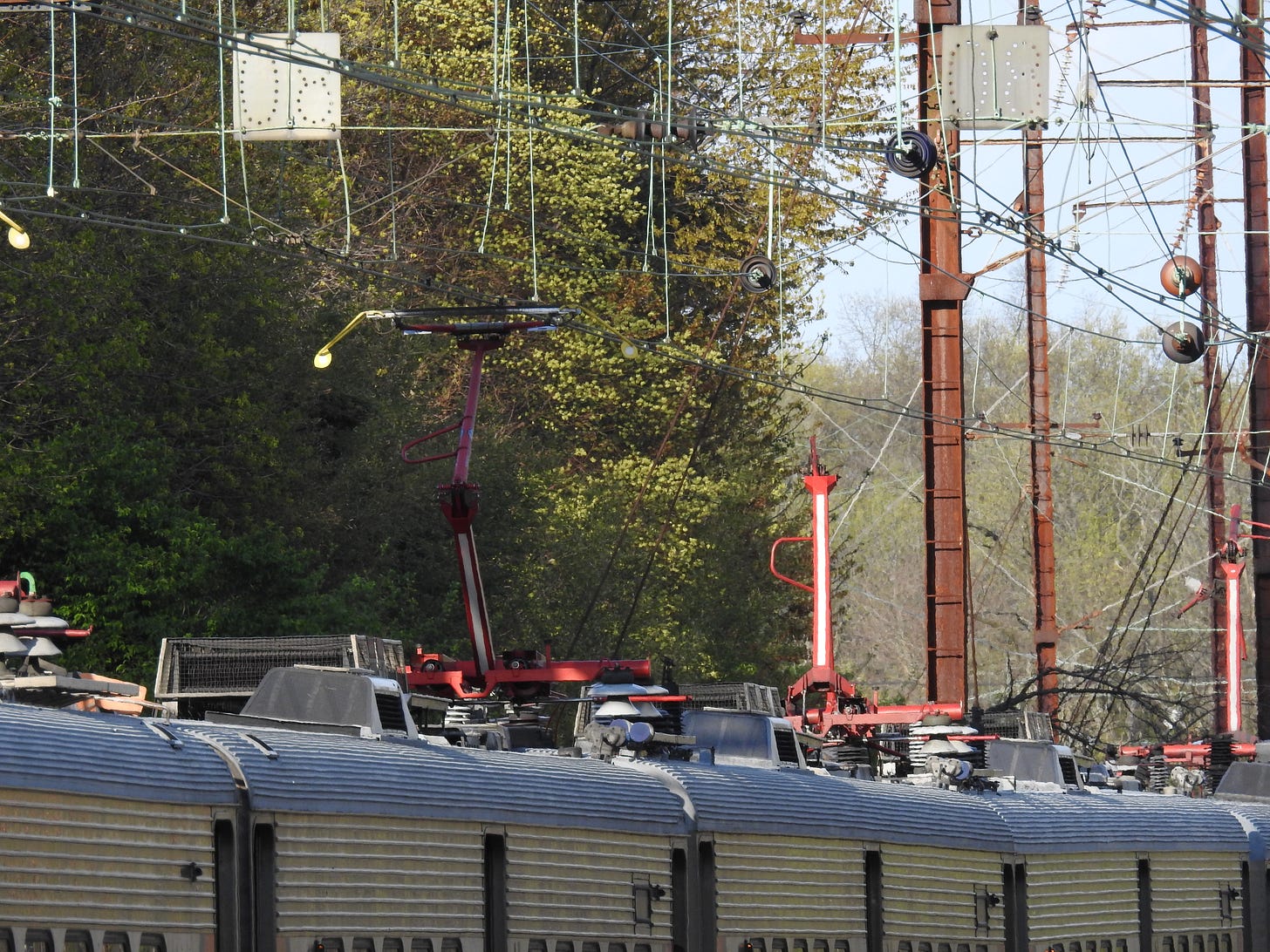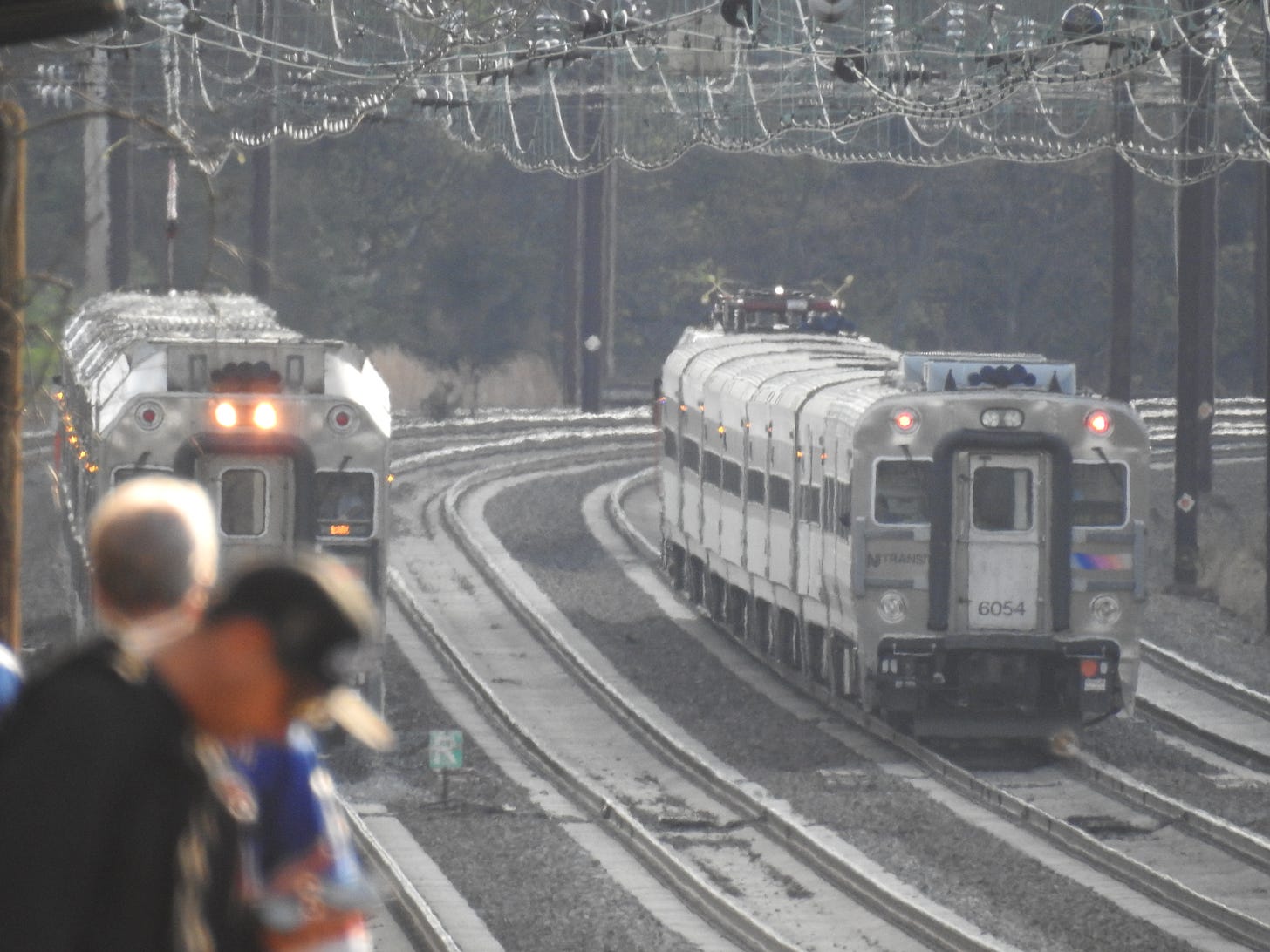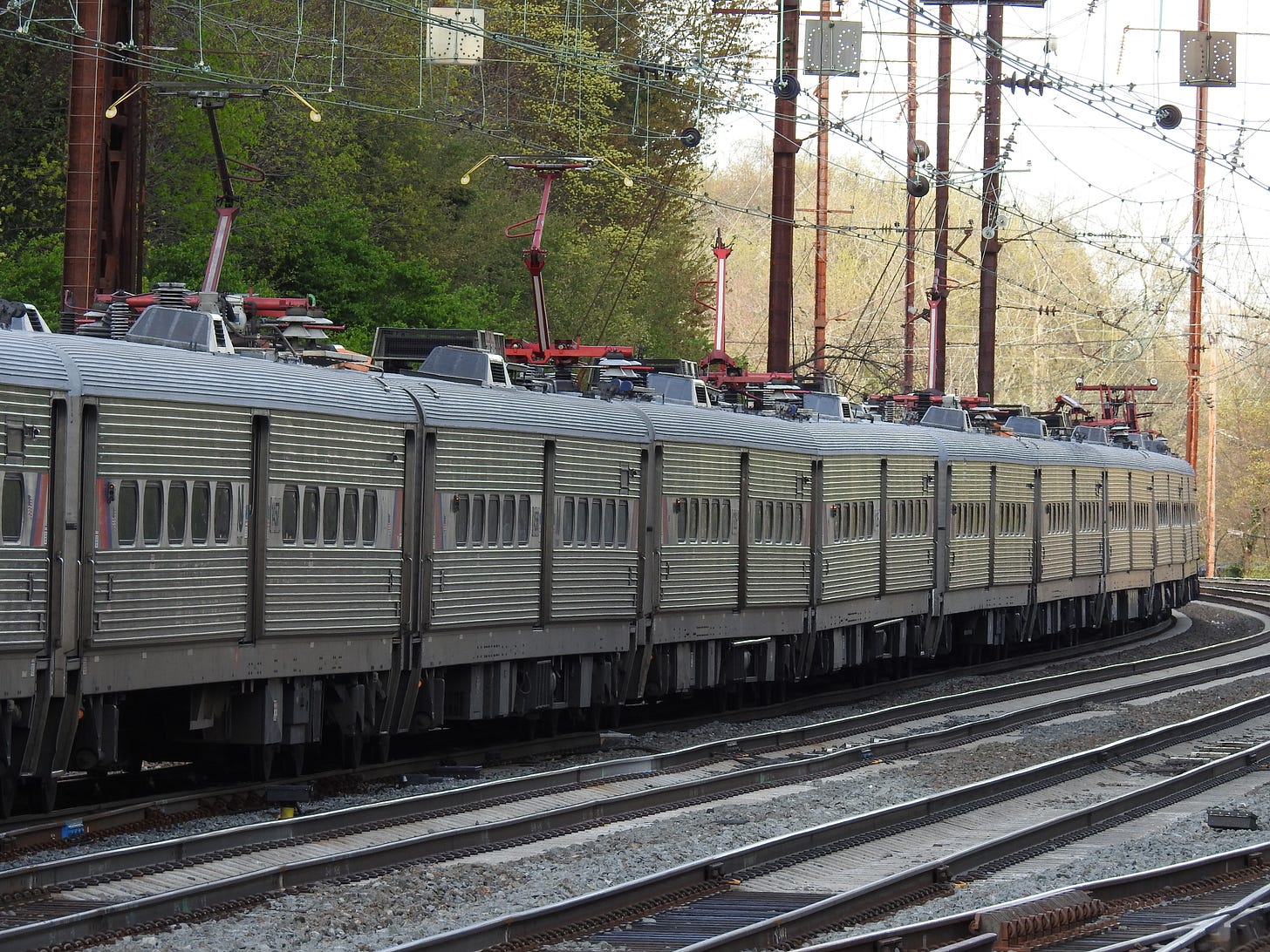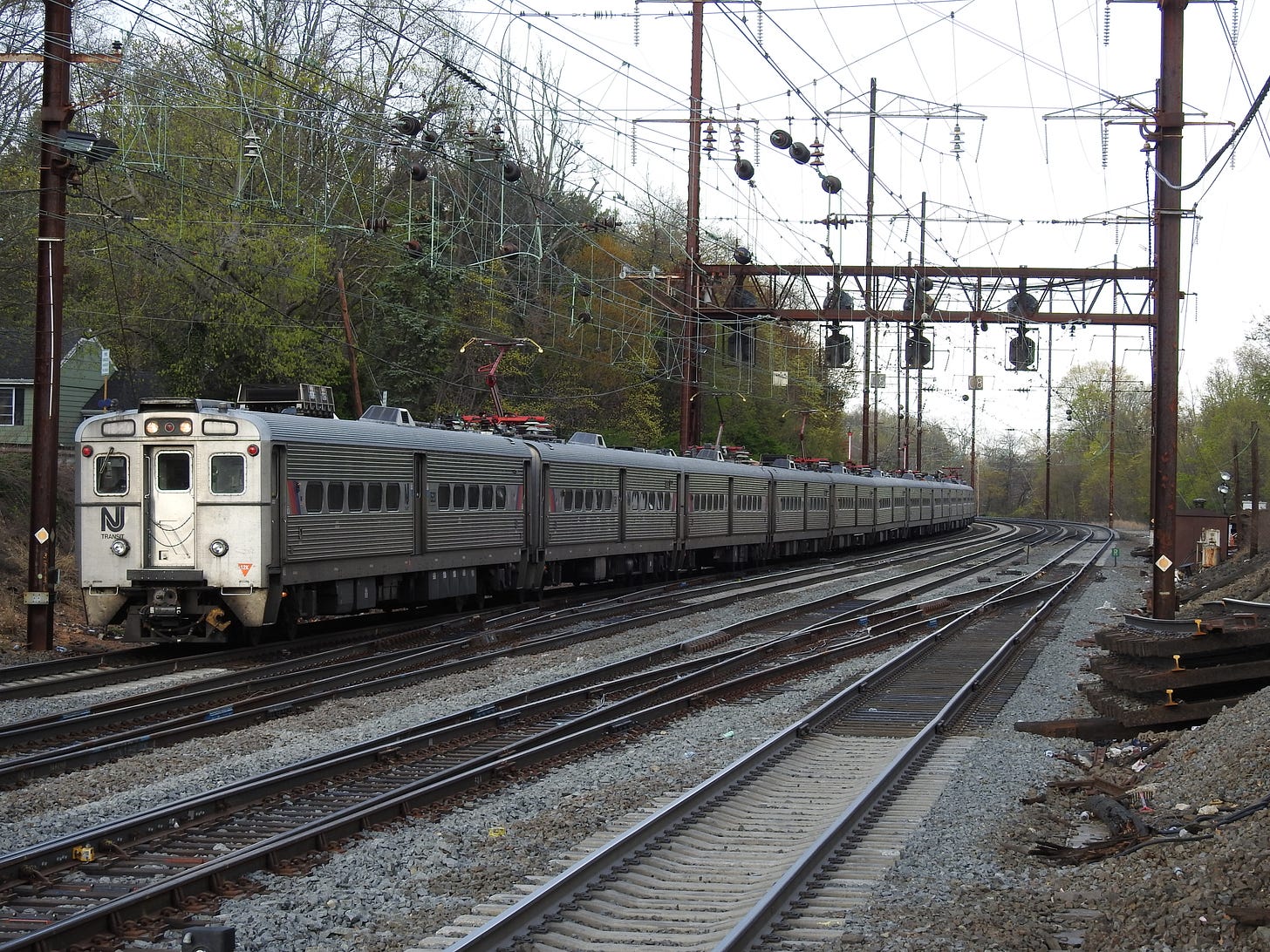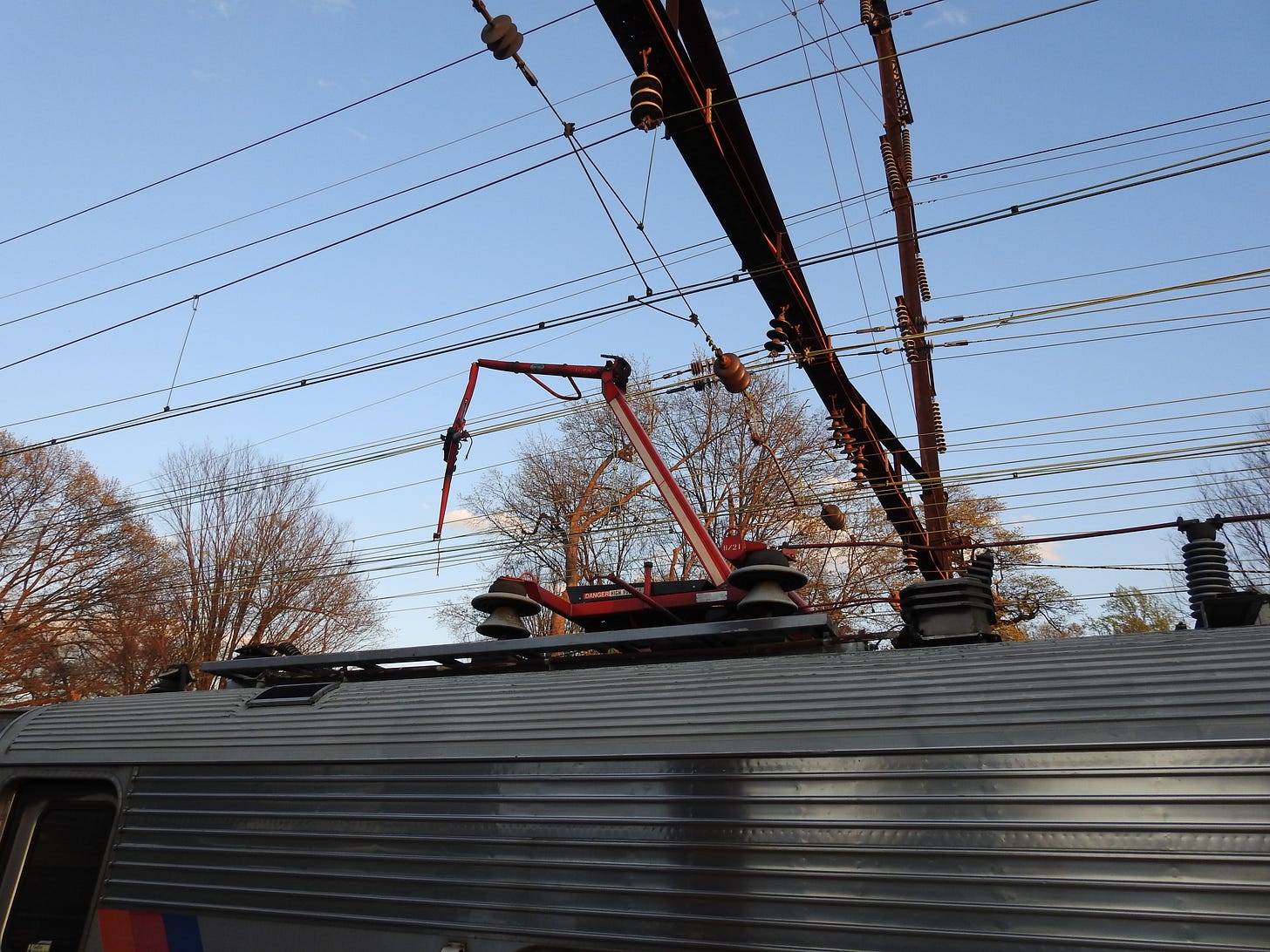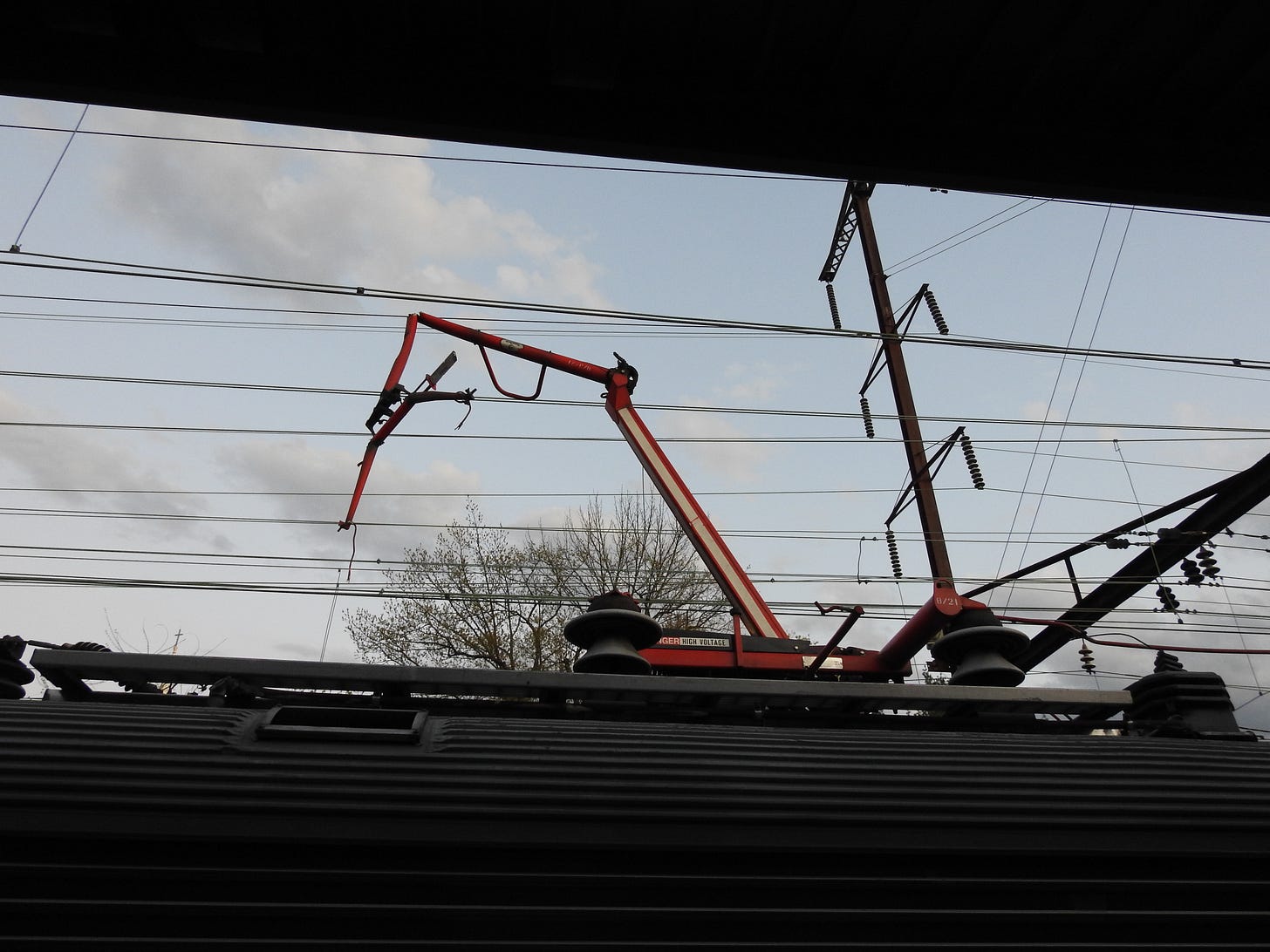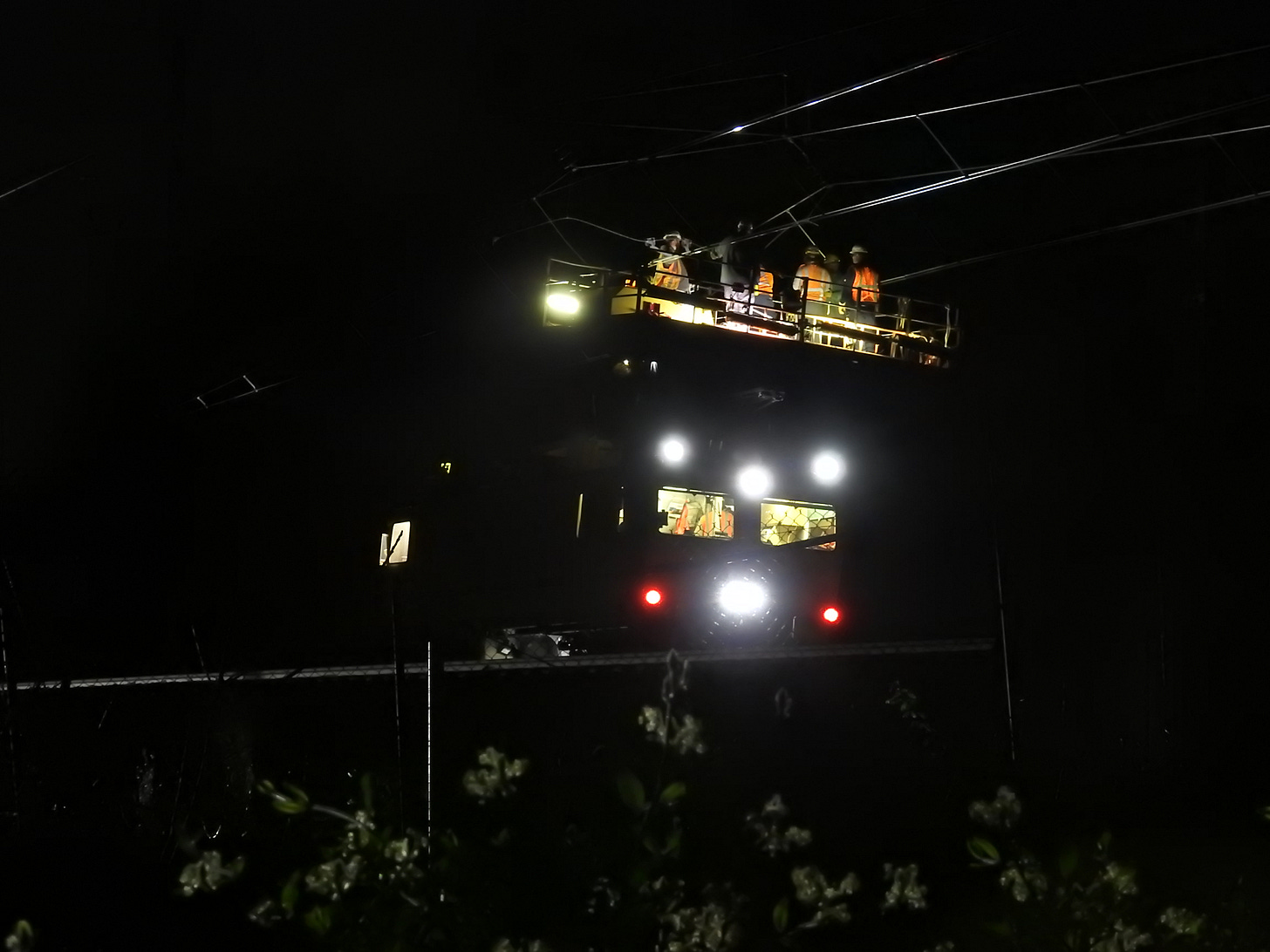Northeast Corridor Catenary Wire Madness (Metuchen, New Jersey - April 15th, 2024)
How did 3 trains break their pantographs on April 15th, 2024? A written and audiovisual story of the events leading to a nightmare evening for thousands and a documentation of the research process
The delays of April 15th, 2024 were the first of a multi-month series of Amtrak and New Jersey Transit delays in the New York area, mostly involving the overhead catenary wires or breakdowns in the tunnels around New York Penn Station. However, because this was the “first” disaster of this proportion of the warm weather season, it seems to be forgotten when covered in media and discussion despite being close to the largest delay incident this year. The gravity of the delays of this specific incident combined with the exclusive captures of radio transmissions and internal records led to the creation of this unique, one-of-a-kind story and an incredible journey in researching, finding and requesting pieces of information.
You will read transcriptions or summaries of radio transmissions from the dispatcher, train conductors and train engineers. You will hear some of the same radio transmissions in original audio form as train crews and dispatchers would hear it. You will see before-and-after pictures extracted from cab videos comparing the before-and-after states of the catenary wire damage. You will see pictures of the pantograph damage. You will learn about the lengthy process that made this possible.
Background
In the case of the Northeast Corridor in New Jersey, owned entirely by Amtrak but with the majority of trains on this section of the line being NJ Transit’s, most trains run on electric power transferred between the train and electrical supply system through a pantograph, a mechanically-controlled arm that is attached to the roof of the train. Pantographs connect to overhead wires called catenary.
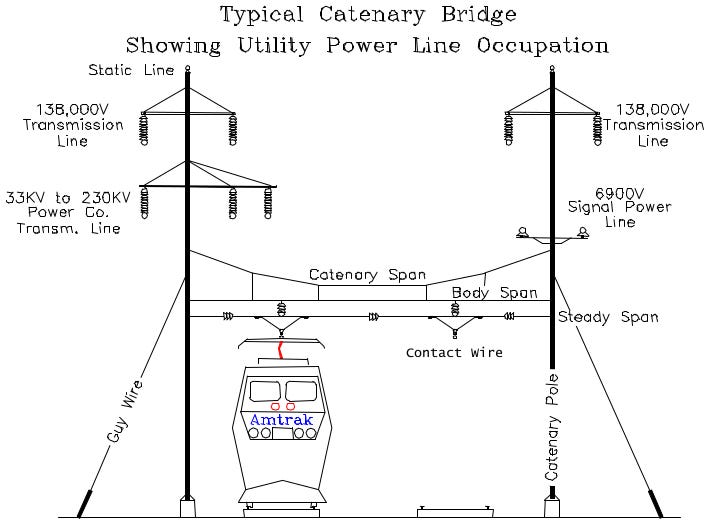


It goes without saying that these systems should not be damaged. Broken pantographs can cause quick damage to the wires and the train, so when a broken pantograph situation has occurred, the train must be stopped and inspected. Improperly tensioned catenary wires can also rip themselves apart (when a force is applied such as a pantograph, the wind or temperature changes) or cause pantographs to break.
Don’t be intimidated if you don’t understand any terms. Many unexplained railroading terms are used here but the pictures and audio should explain most of the story.
Trains involved and direction of travel
This section of the Northeast Corridor uses east and west as railroad directions. From the location of this incident, west is towards New Brunswick, Trenton and Philadelphia and east is towards Newark and New York. Odd numbered trains go west and even numbered trains go east.
NJ Transit #3723: Westbound train to Jersey Avenue (next stop Metuchen)
Consist: 12x Arrow III (electric multiple units)
A multiple unit train means there are motors spread throughout the train. The Arrow IIIs are typically in pairs (with an operator’s cab at each end of the pair) and each pair (or lonely single car) has a single pantograph. This train had 7 pantographs (possibly a factor in why the damage happened in the first place) meaning there were 5 pairs and 2 single cars. The damaged pantographs were the 4 in the rear.
NJ Transit #3947: Westbound to Trenton (next stop Princeton Junction)
Consist: ALP-46A (engine in front) with 9 single-level cars
1 engine normally uses 1 pantograph.
Amtrak #2170: Eastbound to New York/Boston (next stop Newark, New Jersey)
Consist: Acela trainset (standard 6 passenger cars, each end of the train has an engine)
2 engines use 1 pantograph each (2 pantographs total)
NJ Transit #3862: Eastbound to New York (next stop Metuchen/Metropark)
Consist: ALP-46/ALP-46A (engine in rear) with 9 bi-level passenger cars
1 engine normally uses 1 pantograph; this train was not damaged but was the first train to inspect the damage area
Unknown piece of debris resting on the left inside gauge of track 3
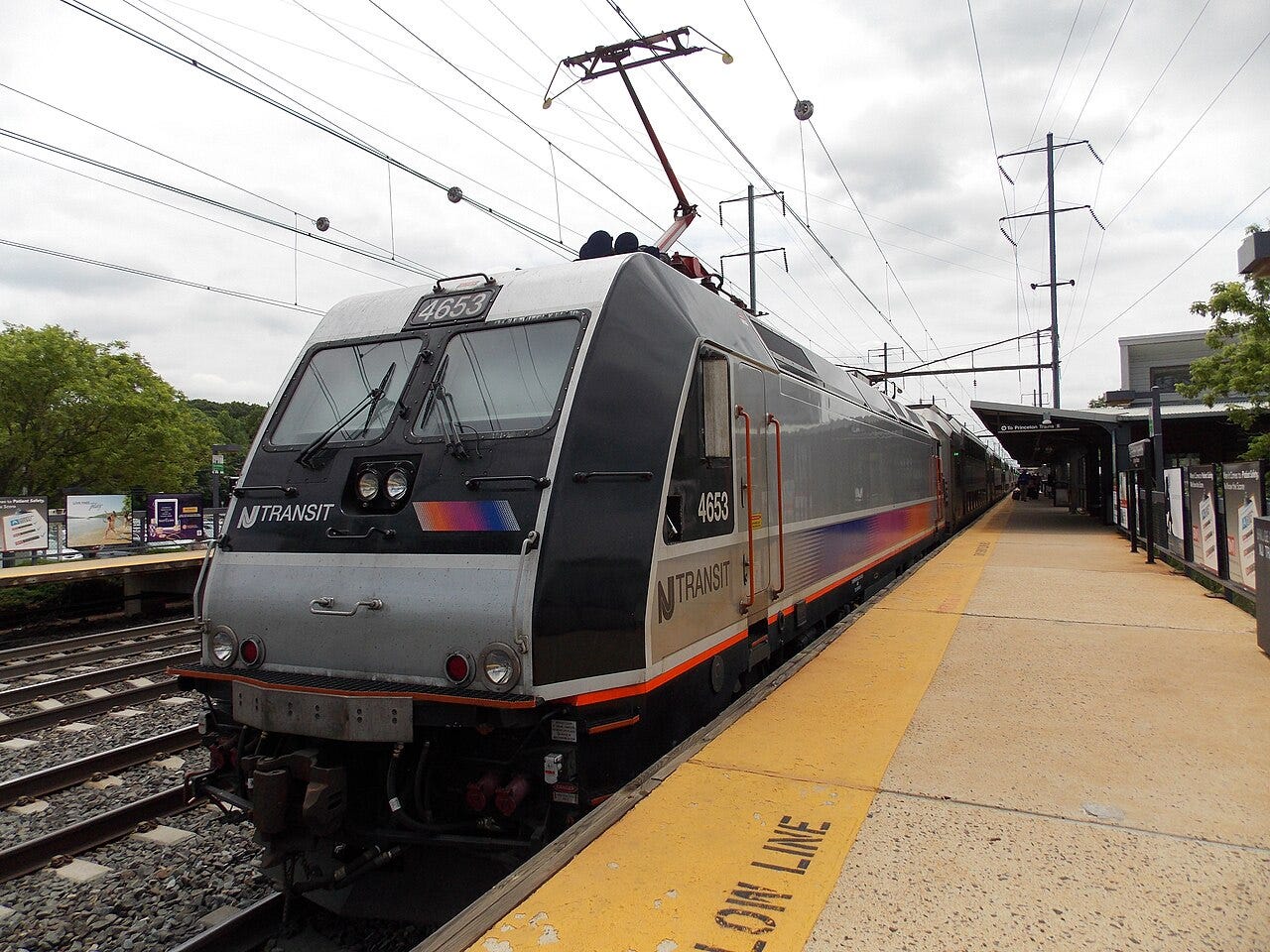
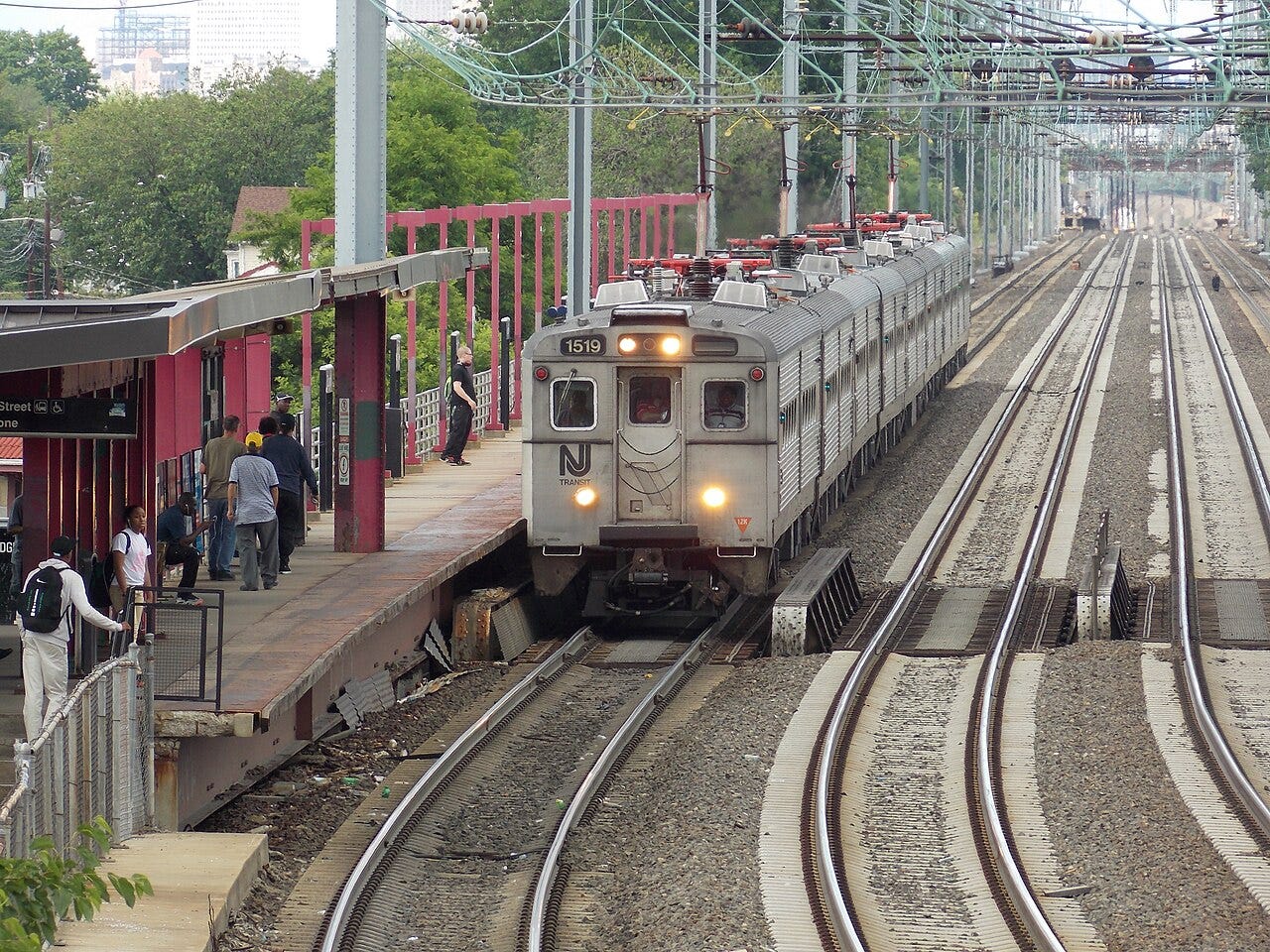
Incident area

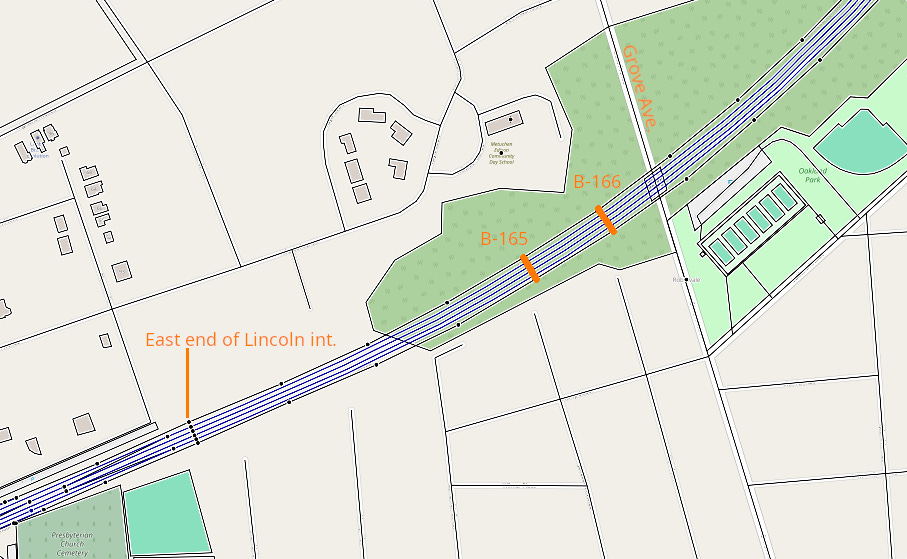

Additional map links and location information
https://www.openstreetmap.org/#map=18/40.543440/-74.353006
https://openrailwaymap.org/?style=standard&lat=40.543440&lon=-74.353006&zoom=18
Cat pole B-165 is at MP 25.38; B-166 is at MP 25.33.
#3723 was 12 cars long or 1020 feet long. It had 5 pairs of multiple units and two independent cars. The independent cars were the 5th and 6th cars in the consist. The forward-most damaged pantograph on the 6th car is estimated to be 446 feet from the head end. The rear-most damaged pantograph is estimated to be 914 feet from the head end on the 11th car.
Sequence of events
Events are reconstructed from cab footage timestamps and radio file recording timestamps. Additional timestamps were derived by interpolation with measuring distances and maps. Cab footage includes timestamps as recorded by the cab video recorder. The cab footage from #3947 and #3862 have audio and the voices from the cabs are faintly captured, so the timing of radio against cab footage from these two trains has been shown to match within 3 seconds. The accuracy of the clock on the footage from #3723’s cab can’t be confirmed.
5:14:27PM - #3723 reaches B-166 which is about to be damaged on track 1
5:14:30PM - #3723 reaches B-165 which is about to be damaged on all tracks

The images from #3723 show that the catenary appears healthy before the train passed it.
5:14:33PM - Nearest to-be-damaged pantograph crosses B-166 (estimated); put another way, the westernmost damaged pantograph, the first pantograph to cross the damage area, crosses the eastern limit of the damage area.
5:14:44PM - Furthest to-be-damaged pantograph crosses B-165 (estimated); put another way, the easternmost damaged pantograph, the last pantograph to exit the damage area, crosses the western limit of the damage area.
The damage to the catenary was likely “complete” at this time. No movement of the catenary was observed in the cab footage.
5:15:13PM - Conductor #3862 gives OK to proceed Edison track 1. The train number and interlocking name (Edison) were not actually heard so this is a good guess based on track number and timing. Engineer does not respond over radio probably due to dealing with loss of power.
5:15:45PM - #3947 tries to contact dispatcher (CETC-8); no response received. The dispatching office was probably on fire at this point, thus no attention could be given and they probably already knew several trains were about to report power issues. The dispatching office is trying to figure out why they lost power on (speculatively) 4 tracks (8 or more circuits – both directions out of Lincoln) and 4 transformers.
5:16:05PM - #3947 gets in contact with dispatcher and reports “5” (5kV) on voltage gauge. Nominal catenary voltage is 12kV.
5:16:38PM - #3723 reports recovery from a penalty but stepped on by dispatcher. #3947 reports they “pretty much lost catenary power”. Dispatcher affirms reception of report from #3947.
5:16:45PM - #3947 appears to lose power near milepost 24.4 after traveling at line speed. The train’s main circuit breaker may open up as a protective measure against undervoltage conditions. Alternatively, the engineer may have throttled to idle and planned to remain that way for a few minutes.
5:17:05PM - #3862 tries to contact dispatcher
5:17:27PM - Amtrak #129 reports departure from New Brunswick; #3723 requests handbrake application from crew; #3862 tries to contact dispatcher again
5:18:05PM - #3862 explains that they lost HEP (head-end power) at track 1 Edison at the same time #3947 reported the issue
5:18:08PM - #3947 appears to regain power and starts accelerating
Amtrak #2170 comes into view as it goes around the curve, apparently having suffered the same loss of traction power as #3947 did.
From left to right:
Registration on track 4, normal appearance
Steady span insulator between tracks 3 and 4, slacked
Registration on track 3, not in correct orientation
Steady span insulator between tracks 2 and 3, slacked
Registration on track 2, slightly out of correct orientation
Steady span insulator between tracks 1 and 2, slacked

5:18:27PM - #3947 reaches B-166
From left to right:
Registration on track 1, not in correct orientation (nearly fouling pantograph envelope)
Insulator between tracks 1 and 2 (blends with trees)
Broken insulator over track 2 fouling pantograph envelope (will damage pantographs of #2170)
Broken hangar over track 2 (pointing about 30 degrees downward from horizontal) fouling pantograph envelope (blends with transmission structures in background; will damage pantograph of #3947)
(ground) Registration from track 3 broken off and on the ground
The steady span is completely missing except over track 1 on the left. See June 11th, 2022 incident at same location (B-165) for actual pictures of a steady span failure at the same exact location.
Left: insulator and registration mangled together over track 2
Right: broken hangar over track 3
Both of these broken pieces are about to cause pantograph damage to #2170 and #3947.
5:18:34PM - #3947 passes B-165
5:18:35PM - #3947 drops pantograph at the same time it strikes the broken wire. The lead pantograph on Amtrak #2170 implicitly strikes the broken insulator 2 seconds later; the rear pantograph about another 15 seconds later.
Prepare for one of the craziest 2 minutes of Amtrak radio recordings:
5:18:41PM - #3947 reports seeing catenary damage and lowering the pantograph; also reports the extensive pantograph damage on #3723; conductor reports pantograph went down but the collector head is upside-down; #3947 continues to coast through Lincoln.
Modern pantographs include an automatic dropping device, which is an air line that runs through or near the carbon strip so that if the pantograph collector head is damaged and the line is ruptured, the entire pantograph will automatically drop in a few seconds. It is not known which types of trains are equipped with such a system, however, it is highly unlikely that ALP-46 and Arrow III trains have such a system. Sample photographs show a distinguished air line on Acela and ACS-64 pantographs that are not present on any other equipment.
Additionally, another typical feature is a pantograph overheight avoidance system that drops the pantograph in case the pantograph is extended too far upwards. The presence of such a system on specific types of trains is also not known and the ability of such a system to have played a critical role in reducing #3723’s damage is also not known.
5:18:50PM - #3862 prepares to stop after hearing the reports of damage everywhere
5:19:39PM - #2170 reports broken pantographs after passing “that train on 1 [sic]”
Acela locomotives can report broken pantographs in the “message board”. It should be in a format like “PANTO F BROKEN” and “PANTO R BROKEN”. This likely means the air line that runs through the pantograph head had ruptured. Source: Manual for Acela HHP-8, a similar engine
Evidently, despite being from the year 2000, Acela locomotives are “higher tech” and do have more advanced technological systems for pantograph management and status. The ACS-64 locomotive, in service around 2014, likely has even more advanced pantograph management systems such as reporting “catenary shake” as #94 experienced later in the day.
End of attached audio recording
5:20:00PM - #3862 comes to a complete stop at the western limits of Lincoln interlocking
5:20:08PM - #3947 passes #3862 (pictured)

5:20:14PM - #3723 requests another brake test from the crew
The crew of #3723 still does not realize they have 4 broken pantographs
5:20:20PM - #3862 mentions upside-down pantograph [head] to #3947. #3947 mentions damage on tracks 2, 3 and 4.
5:20:39PM - #3947 comes to a complete stop west of Lincoln interlocking next to #3862
5:20:37PM - CETC-9 requests #3861 hold in Metropark. Dispatchers need to strategically get trains to hold, preferably in stations.
All trains near the incident area should be stopped at this point
5:21:14PM - #3947 requests handbrake application from conductor
After this line, many unimportant messages are skipped
5:21:50PM - #2170 explains that they’re stopped at automatic signal 246 (milepost 24.6) and that both pantographs are broken as indicated on the message board.
5:22:28PM - #3862 requests permission to stop at Metuchen and continue. The answer is no.
5:22:40PM - #3723 announces recovery from a penalty and requests permission to continue. Dispatcher requests inspection of the catenary by #3723.
5:23:04PM - #3947 reiterates that there is damage on tracks 3 and 4 east of Lincoln
5:24:00PM - Conductors on #3723 start to figure out they lost power in the back
5:24:58PM - #3723 reports loss of power in last 3 cars and that the conductor is walking back to check pantographs
5:25:28PM - Conductors of #3723 confirm at least one broken pantograph
5:27:54PM - #2170 gets permission to try to raise other pantographs to get power
5:29:15PM - #2170 gets permission to go east if able
Skip
5:42:03PM - #3862 is given permission to operate AMT 2.602 (catenary damage/caution rule) to Metropark
5:44:19PM - #3723 is asked by the dispatcher if they can reconfigure to get head-end power (Arrow III multiple units do not exactly have HEP because each pair or single car independently sources its power from the catenary)
5:45:22PM - Unknown voice (probably conductor in cab) from #3947 mocks the idea of #3723 moving with its pantograph damage. #3947 reports successful pantograph change and receives permission to continue west.
5:45:50PM - #3723 asks crew if pantographs can be dropped
5:46:22PM - After discussion with the crew, #3723 asks for a rescue
5:46:33PM - Dispatcher asks #3947 to stop
5:48:05PM - Dispatcher clarifies that Electric Traction (ET) wants to look at the train
End of selected radio transcripts
#3862 inspects the damage
#3862 was the first train through the incident area. The engineer of #3862 reported damage to the dispatcher and to the damaged trains as the train moved through the area.
NJ Transit retained the footage from #3862 likely because it showed the extent of the damage without the train itself being part of the damage.
From left to right:
Broken insulator over track 2 that broke #2170’s pantographs
Slacked insulator between tracks 1 and 2
Registration fouling the pantograph envelope over track 1 (could have damaged more pantographs in the following hours, but apparently did not)
Slacked steady span (left part of span, out of view over tracks 3 and 4, is completely disconnected)
From left to right:
Insulator between tracks 2 and 3 is slacked and registration over track 2 is in bad shape
Insulator between tracks 1 and 2 is slacked
Registration over track 1 is slightly out of correct shape
Steady span is slacked

The pantograph damage
This batch of pictures (this section only) was taken between 5:40PM and 6:00PM unless otherwise noted.
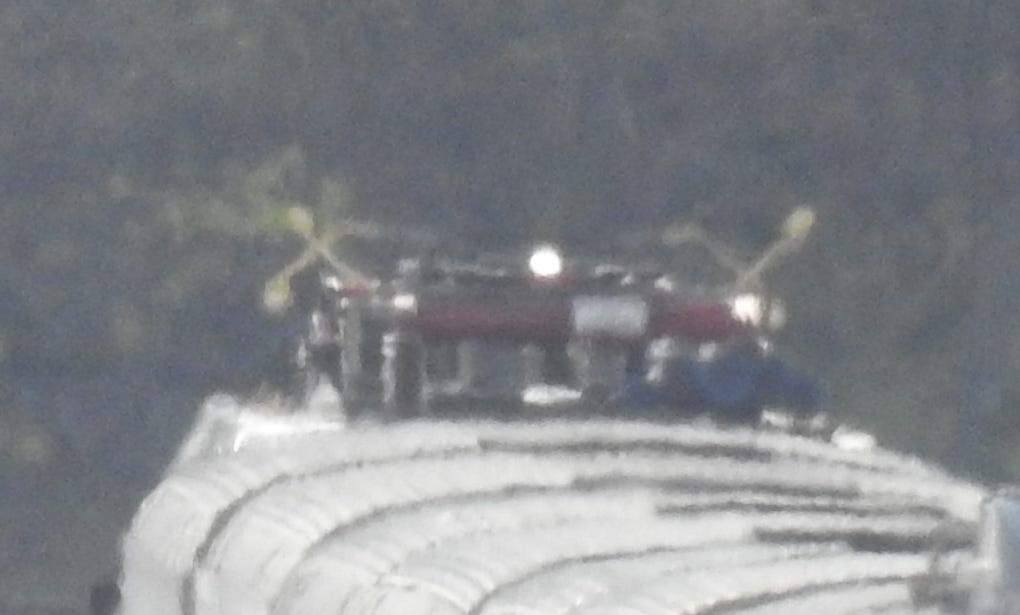
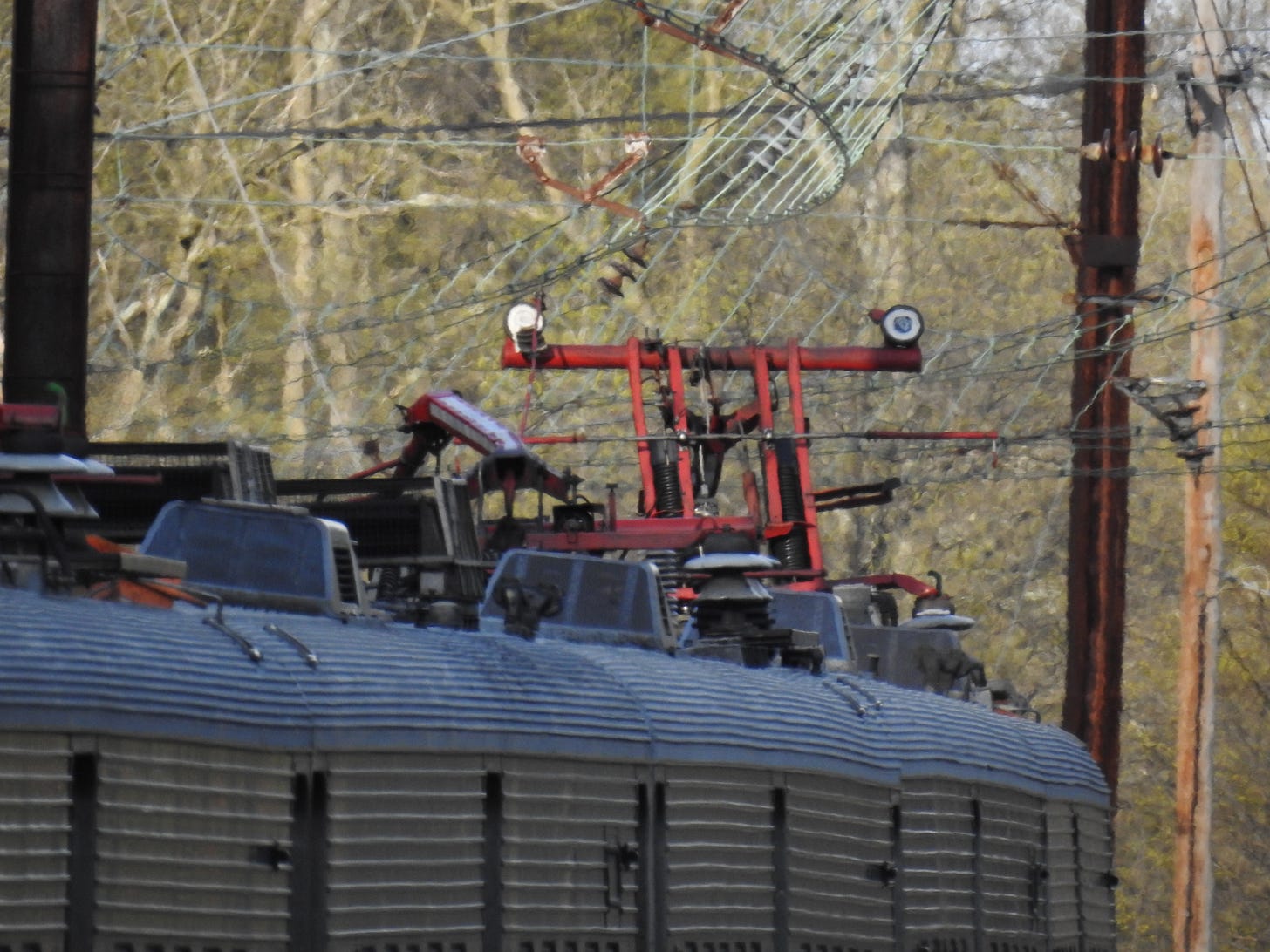

Events throughout that day
Around 6:06PM, #3723 reported passengers jumping off the train. Local police were called in to handle the situation. #3723 was not moved until around 7:05PM, nearly 2 hours after stopping at 5:15PM. The train was moved again at 7:19PM to allow a passenger with a mobility device in the back to exit at the platform.
#3947 was finally allowed to continue the second time at 7:07PM. Its minimal damage and alternate pantograph allowed it to finish its trip.
The passengers from #2170 were transferred to Amtrak #20 despite the estimation by the crew of #20 that the 200 passengers would not fit. The transfer completed before 7:10PM.
#2170 was not successful in raising the remaining pantographs and was rescued many hours later as seen by this data log. #3723 had the broken parts of pantographs sawn off after 9PM. The train was moved after midnight by a rescue engine.
Track 1 was the only operating track available once #3862 reported it was OK for travel. However, the catenary wire was in bad shape, as seen in the pictures when #3862 went under it, and a drop pantograph order was placed after 8PM. The drop pantograph order was delivered to each train before they were allowed to pass the area.
At 7:32PM, Amtrak #94 reported a catenary shake and main circuit breaker opening (protection mechanism if voltage drops, which might happen if the pantograph loses contact) when passing east of Lincoln on track 1. The dropping of temperatures as night fell may have altered the tension and shape of the unstable catenary wire.
Around 7:37PM, Amtrak #652 worked with ET on the ground to discuss the strategy: gain enough momentum and drop the pantograph through the area. Afterwards, trains were formally instructed by Form D to drop the pantograph at the specific location, starting with Amtrak #80 effective 8:53PM.
At 8:10PM, the catenary car left Colonia siding. The car entered into the track 3 out-of-service block (Menlo - Lincoln) at 9:03PM. Amtrak’s incident report says that repairs began at 9:36PM.
NJ Transit #3169 was stopped near Metropark and was given the drop pantograph order for track 1 (Grove Ave MP 25.32 - Lincoln) at 10:23PM. As this was a westbound move over track 1, “line 2” movement authority had to be granted to operate against the direction of signals. This kind of track is known as “Track Signaled in One Direction” under NORAC Rule 251. The dispatcher gave a verbal reading of the form D over the radio:
Form D number A828
Date 4 15 24
Addressed to C and E NJT number 3169 engine 1364 at Iselin
Drop down circle 2: operate in west direction on NYP line, number 1 (ONE) track between Menlo and Lincoln
Drop down circle 13, other instructions and information: a drop pantograph is in effect on NYP line number 1 (ONE) track between Grove St, [sic] milepost 25.32, and Lincoln
Operate according to AMT-2 2.310
…
Time effective: 10:23PM
The engineer of #3169 correctly read the Form D back to the dispatcher. At 10:55PM, #3169 was filmed passing through the drop pantograph area with its pantographs still up.
Mister President, a second Arrow trainset has struck the catenary…
Audio summary: conversation with “40” Office (New York Dispatching Office), ET foreman and engineer of #3169. The engineer’s voice was omitted to save embarrassment. The engineer said “apparently not; I thought I did.” when answering 40 Office at 44 seconds in, after which an unknown voice at the end says “oh my god”.

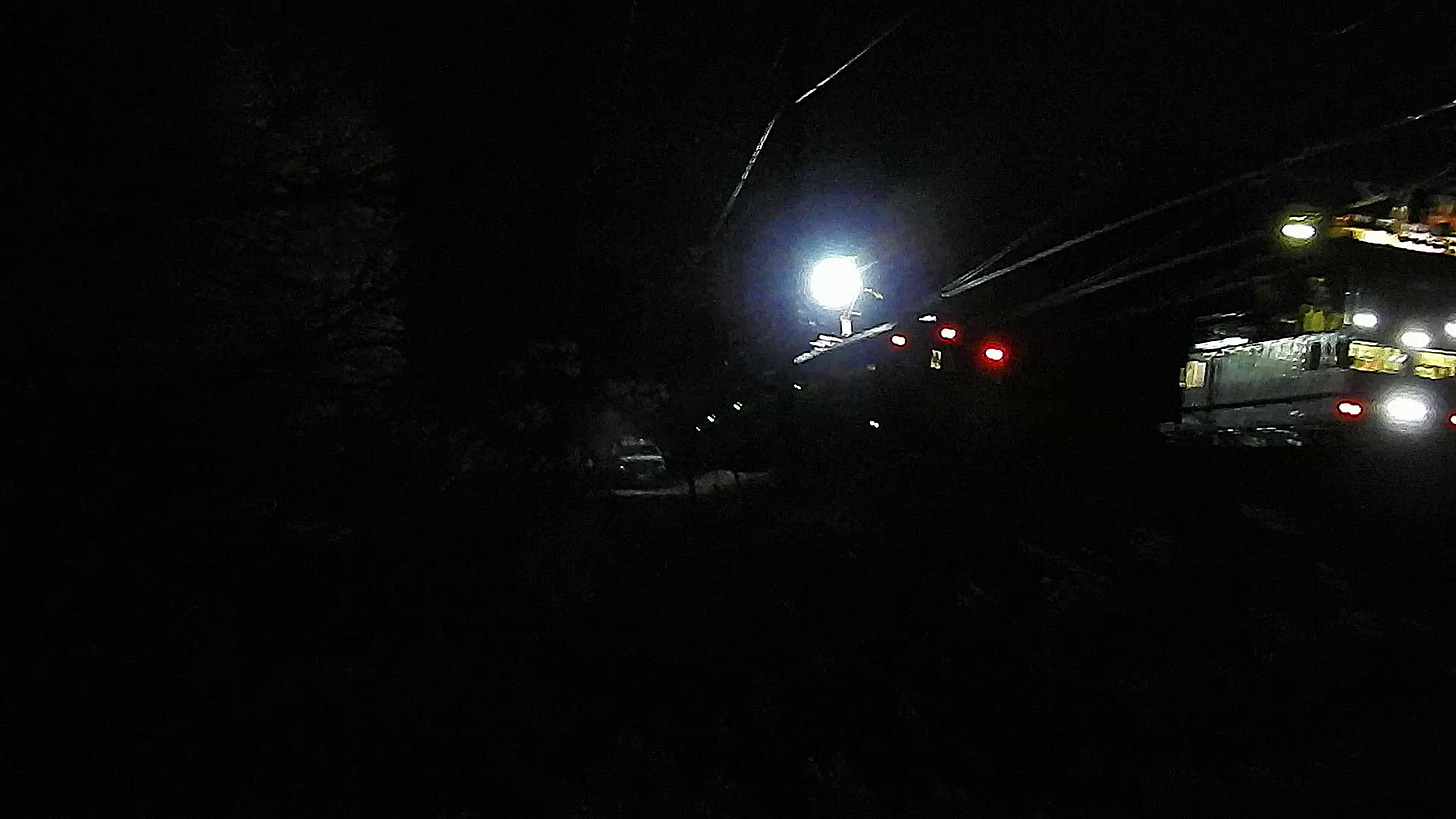
#3169 left after inspection by ET employees with no apparent damage to the pantographs.
According to Amtrak’s report, the steady span was then fouling track 1 and this left no remaining tracks to route trains. The next train that finally went through appeared to be #196 at 12:35AM but this appears to be an exception.
According to radio communications (form D cancellation) between the dispatcher and the foreman:
Track 3 was reopened with no restrictions at 1:50AM.
Track 1 was reopened at 2:21AM.
Track 2 was reopened at 2:32AM.
Track 4, the track with the most catenary damage, was reopened at 3:27AM.
Other news coverage and discussion
Tweet: "Desperate times, desperate measures. Passengers exit between cars on a @NJTRANSIT train stuck just east of Metuchen station because of Amtrak wire issues."
https://xcancel.com/ReichNow/status/1780001516247461939 (xcancel) | https://x.com/ReichNow/status/1780001516247461939 (Twitter/X)
Video from Tweet: https://video.twimg.com/ext_tw_video/1780001424891338752/pu/vid/avc1/1280x720/xxggbXt8Q9n5Ffvp.mp4 | https://web.archive.org/web/20241113012409/https://video.twimg.com/ext_tw_video/1780001424891338752/pu/vid/avc1/1280x720/xxggbXt8Q9n5Ffvp.mp4 (archived)
Tweet: "Disabled @NJTRANSIT finally moved to the station platform at Metuchen a few minutes ago."
https://xcancel.com/ReichNow/status/1780011668552003658 (xcancel) | https://x.com/ReichNow/status/1780011668552003658 (Twitter/X)
Video from Tweet: https://video.twimg.com/ext_tw_video/1780011424523165697/pu/vid/avc1/1280x720/-d6G-JusMgcMJua6.mp4 | https://web.archive.org/web/20241113012024/https://video.twimg.com/ext_tw_video/1780011424523165697/pu/vid/avc1/1280x720/-d6G-JusMgcMJua6.mp4 (archived)
Twitter - NJ Transit and Amtrak
Tweet: “Northeast Corridor rail service is suspended in both directions between New York and Trenton due to Amtrak overhead wire issues near Metuchen.”
https://xcancel.com/NJTRANSIT_NEC/status/1779996159018152194 (xcancel) | https://x.com/NJTRANSIT_NEC/status/1779996159018152194 (Twitter/X)
Tweet: “UPDATE: As of 7:06 PM ET, Due to rail congestion resulting from overhead power issues, All Trains traveling between New Brunswick (NBK) and New York (NYP) will experience delays of at least 3 hours. We greatly appreciate your patience and understanding. Updates to come.”
https://xcancel.com/AmtrakNECAlerts/status/1780010255579050304 (xcancel) | https://x.com/AmtrakNECAlerts/status/1780010255579050304 (Twitter/X)
Reddit data was searched with this tool:
The subreddits chosen to find submissions were /r/amtrak and /r/njtransit between 2024/04/15 9:00PM and 2024/04/20 12:00AM (UTC) and the results were manually curated. Each Reddit page was retrieved using safereddit.com (redlib instance; private and simple way to access Reddit) and archived from that.
https://www.reddit.com/r/NJTransit/comments/1c4xzha/my_train_just_ran_over_something_pretty_intense/ | https://safereddit.com/r/NJTransit/comments/1c4xzha/my_train_just_ran_over_something_pretty_intense/ | https://web.archive.org/web/20241127081431/https://safereddit.com/r/NJTransit/comments/1c4xzha/my_train_just_ran_over_something_pretty_intense/
My train just ran over something pretty intense. NECL, Metuchen.
https://www.reddit.com/r/NJTransit/comments/1c51sqt/nj_transit_suspended_the_nec_indefinitely_it/ | https://safereddit.com/r/NJTransit/comments/1c51sqt/nj_transit_suspended_the_nec_indefinitely_it/ | https://web.archive.org/web/20241127081358/https://safereddit.com/r/NJTransit/comments/1c51sqt/nj_transit_suspended_the_nec_indefinitely_it/
NJ Transit suspended the NEC indefinitely. It makes me nervous
https://www.reddit.com/r/NJTransit/comments/1c5209q/why_does_nj_transits_service_suspensions_always/ | https://safereddit.com/r/NJTransit/comments/1c5209q/why_does_nj_transits_service_suspensions_always/ | https://web.archive.org/web/20241127081353/https://safereddit.com/r/NJTransit/comments/1c5209q/why_does_nj_transits_service_suspensions_always/
Why does NJ Transit's service suspensions always due to Amtrak..when Amtrak is always running normally?
https://www.reddit.com/r/NJTransit/comments/1c57k23/nec_worse_day_ever_rant/ | https://safereddit.com/r/NJTransit/comments/1c57k23/nec_worse_day_ever_rant/ | https://web.archive.org/web/20241127081433/https://safereddit.com/r/NJTransit/comments/1c57k23/nec_worse_day_ever_rant/
NEC worse day ever (rant)
https://www.reddit.com/r/NJTransit/comments/1c5dm7v/trains_all_cancelled_this_morning_nec/ | https://safereddit.com/r/NJTransit/comments/1c5dm7v/trains_all_cancelled_this_morning_nec/ | https://web.archive.org/web/20241127081512/https://safereddit.com/r/NJTransit/comments/1c5dm7v/trains_all_cancelled_this_morning_nec/
Trains all cancelled this morning NEC
https://www.reddit.com/r/NJTransit/comments/1c5vwhf/what_will_it_really_take_to_fix_nj_transit/ | https://safereddit.com/r/NJTransit/comments/1c5vwhf/what_will_it_really_take_to_fix_nj_transit/ | https://web.archive.org/web/20241127081523/https://safereddit.com/r/NJTransit/comments/1c5vwhf/what_will_it_really_take_to_fix_nj_transit/
What Will It REALLY Take to fix NJ Transit?
https://www.reddit.com/r/Amtrak/comments/1c516s4/does_anyone_have_any_insight_as_to_what_actually/ | https://safereddit.com/r/Amtrak/comments/1c516s4/does_anyone_have_any_insight_as_to_what_actually/ | https://web.archive.org/web/20241127081450/https://safereddit.com/r/Amtrak/comments/1c516s4/does_anyone_have_any_insight_as_to_what_actually/
Does anyone have any insight as to what actually is going on around NYP?
https://www.reddit.com/r/railroading/comments/1c53ffk/northeast_corridor_catenary_damage_causes/ | https://safereddit.com/r/railroading/comments/1c53ffk/northeast_corridor_catenary_damage_causes/ | https://web.archive.org/web/20241127081654/https://safereddit.com/r/railroading/comments/1c53ffk/northeast_corridor_catenary_damage_causes/
Northeast Corridor Catenary Damage Causes Pantographs Damage (Metuchen, NJ)
https://www.reddit.com/r/Amtrak/comments/1c58rle/any_other_poor_souls_stuck_in_metropark_nj_just/ | https://safereddit.com/r/Amtrak/comments/1c58rle/any_other_poor_souls_stuck_in_metropark_nj_just/ | https://web.archive.org/web/20241127081506/https://safereddit.com/r/Amtrak/comments/1c58rle/any_other_poor_souls_stuck_in_metropark_nj_just/
Any other poor souls stuck in Metropark NJ? Just passed 4 hours on this train stopped without an ETA
Other outlets
ABC 7 news: https://abc7ny.com/disabled-amtrak-train-in-metuchen-nj-disrupts-new-jersey-transit-northeast-corridor-service-wire-issues-near-jersey/14670732/ | https://web.archive.org/web/20240416005031/https://abc7ny.com/disabled-amtrak-train-in-metuchen-nj-disrupts-new-jersey-transit-northeast-corridor-service-wire-issues-near-jersey/14670732/
Trains.com: https://www.trains.com/trn/news-reviews/news-wire/amtrak-nj-transit-northeast-corridor-service-snarled-by-catenary-issues/ | https://web.archive.org/web/20240526115441/https://www.trains.com/trn/news-reviews/news-wire/amtrak-nj-transit-northeast-corridor-service-snarled-by-catenary-issues/
The end! The following are footnotes and unorganized thoughts.
Thought - the record request process
Amtrak is not a federal government agency but has special provisions in FOIA law to make it subject to such due to its quasi-public status and ownership by the federal government. For FOIA purposes it behaves much like any other federal government agency. Amtrak accepts FOIA requests through mail or through its web portal.
NJ Transit is subject to New Jersey’s Open Records Public Act (OPRA). NJ Transit accepts OPRA requests by mail, email and fax. Records responsive to OPRA requests, by judicial precedent, are allowed to be used commercially thus are de facto public domain.
All requests made were delivered free of charge as they likely didn’t hit any fee thresholds.
Thought - Unavailable records
Amtrak claims that the cab footage from #2170 was not retained (footage is probably kept in the camera unit on the order of 24 hours) and it’s not clear it would have been released by FOIA anyway. It’s possible Amtrak dismissed the incident as solely caused by NJT #3723 and deemed it unnecessary to extract the footage. It’s too bad because it may have captured NJT #3947’s pantograph getting damaged and how timely that engineer was in dropping the pantograph.
Amtrak responded to the request for CETC logs (train and track occupancy timing, low voltage event timing) with the same incident report, although it’s also not clear whether it would have released. The FOIA agent said the responsible department said it’s all they have. CETC logs could have explained some power events as received by trains and whether there was a signal anomaly causing a penalty for #3723.
Thought - Federal Railroad Administration records
Railroads report personal injuries and equipment damage in reports filed with the US DOT/FRA. For equipment damage, this is called Form 54.
This is the FRA’s dashboard for railroad personal injury and equipment damage reports: https://railroads.dot.gov/safety-data/accident-and-incident-reporting/overview-reports/accidentincident-dashboards-data
Many incidents are described within the records, including the April 2024 incident and the June 2022 incident, as outlined in the next section.
Only Amtrak had a Form 54 filing, referenced as ATK 179358:
PANTOGRAPH/CATENARY: TRAIN 2170(15) WITH SET 17 AND PC 2022 2011 REPORTED PANTOGRAPH DAMAGE ON BOTH POWER CARS EAST OF LINCOLN/MP 26.0 ON THE AMTRAK NYP LINE 2 TRACK WITH LOSS OF HEP.
Thought - June 11th, 2022 incident at same location (B-165)
NEC Commission yearly reports include lists of major delays on the Northeast Corridor and some connected lines. Searching these proved to be a great idea. A FOIA request was sent to Amtrak and the incident summary for an incident on this day was received within only 1 business day.
An image from a Tweet from 2022 revealed that the damaged train was also an Arrow III set.
https://xcancel.com/kaitlinkowalec/status/1535750055440818180 (xcancel) | https://x.com/kaitlinkowalec/status/1535750055440818180 (Twitter/X)
Image from Tweet: https://pbs.twimg.com/media/FVAUherXEAI9WTX?format=jpg (direct) | https://web.archive.org/web/20220611223056/https://pbs.twimg.com/media/FVAUherXEAI9WTX.jpg:large (archive)
FRA Form 54 (NJTR 202206258 and ATK 171414) filings also indicated it was an Arrow III consist:
NJTR TRAIN #7859 SUSTAINED DAMAGE TO PANTOGRAPH ON EMU CAR #1427 8TH IN THE CONSIST WHILE ENROUTE WEST APPROACHING METUCHEN STATION DUE TO AN AMTRAK CATENARY SYSTEM DEFECT.
Links: https://safetydata.fra.dot.gov/Officeofsafety/Publicsite/FORM54/F54Report.aspx?RepType=SQL&txtf54key=NJTR20220625820220611 https://safetydata.fra.dot.gov/Officeofsafety/Publicsite/FORM54/F54Report.aspx?RepType=SQL&txtf54key=ATK17141420220611
There are many incidents in FRA data to go through (with clear descriptions of train consists) so not everything has been examined; finding this 2022 incident was a little bit of “luck” given that it was in the same exact location as the April 2024 incident and may provide exceptional insights.
Having seen the slight mistakes in the April incident report, I do not fully trust the order of events or accuracy. These are the events and circumstances from Amtrak’s report:
- 5:54PM NJT #7859 is stopped in Lincoln; reported pantograph damage and loss of power
Note: It is not clear how the crew knew there was pantograph damage or whether it was suspicion.
- Power director reports loss of power on 3804 trolley circuit
Note: 3804 can be inductively understood as Substation 38 (Metuchen Sub) and track 4. This circuit should run from Substation 38 to Substation 39 at Union interlocking in Rahway, a distance of about 6 miles.
- Amtrak #669 also came to stop inside Lincoln interlocking with pantograph damage
Note: #669 is Keystone service so it would have at least one ACS-64 engine. Some Keystones ran with two engines at various times in the last few years: one at each end.

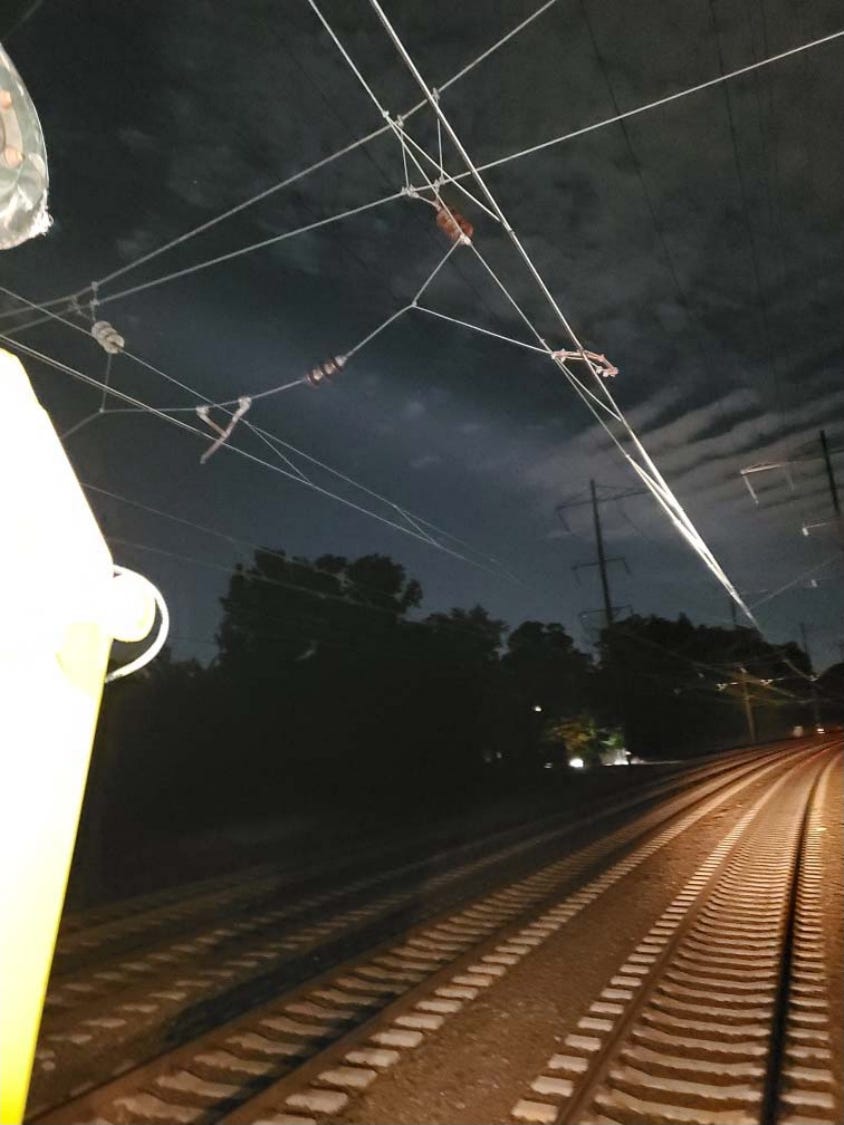
Thought - the British incident
A November 2013 report from the UK entitled “Accident involving a pantograph and the overhead line near Littleport, Cambridgeshire 5 January 2012” was a major inspiration for this article and helped a bit with terminology. In that incident, a multiple unit electric train had a pantograph dewired. The pantograph shot up above the contact wire and eventually hit a cantilever structure. The collision with the cantilever structure caused the pantograph and its assembly to detach from the roof and smash windows as it came down, causing injury to a passenger. More can be read at the report here: https://www.gov.uk/raib-reports/accident-involving-a-pantograph-and-the-overhead-line-near-littleport-cambridge

The report from Amtrak does not mention if any droppers were broken on track 4 by #3723 but the British incident remains similar to this one. That no droppers were broken is plausible because this incident was on a curve where the messenger wire is deflected far to the left, so a pantograph that shoots up probably would not hit the messenger wire or the droppers.
Thought - Pantograph-catenary deviation
While researching catenary-pantograph interaction at the specific incident location, we found interesting behavior among Arrow III pantographs.
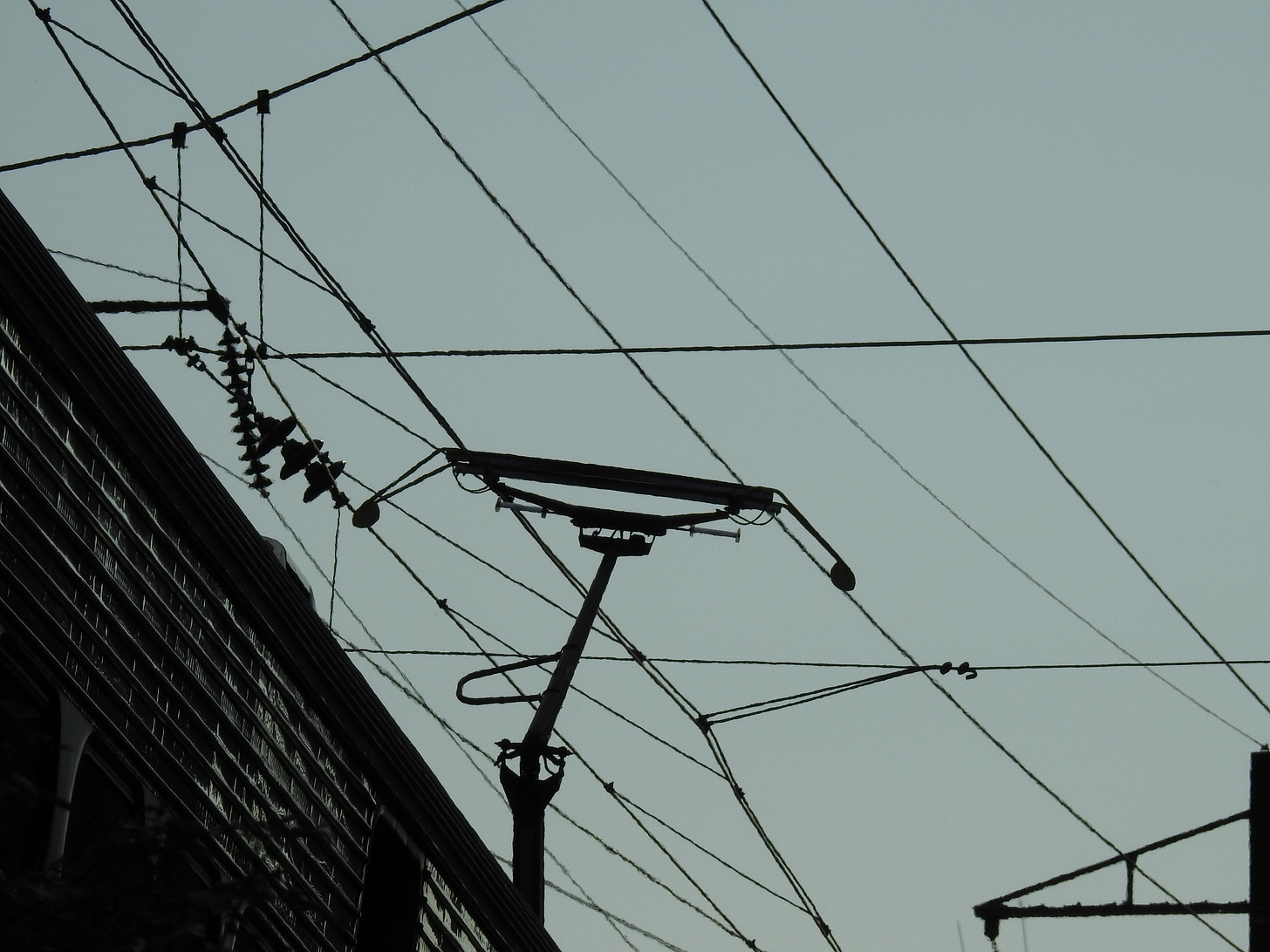
We’ll leave it to the professionals and insiders to determine whether this kind of behavior is normal and within tolerances. Quick analysis at other locations showed this might be normal. However, it doesn’t take much imagination to notice that it wouldn’t take much deviation to throw the pantograph off the wire and cause dewirement.
Additionally, the registration over track 4 (in this case, a two-wire kind instead of a mechanical bracket) seems to “pull” the trolley wire awkwardly. Arrow III pantographs seem to sometimes audibly hammer this spot.
A specific set of circumstances can cause a train (and specifically Arrow IIIs) to stop in this specific location:
#3723 is quite long with 12 cars. It appears to get this specific consist (12 cars) every day.
Amtrak #129 needs to make New Brunswick and must cross to track 4 at Lincoln / Metuchen. This specific movement would frequently stop #3723 at Lincoln and was used to take the pantograph pictures and video.
The ACSES II system (positive train control), installed and completed in the late 2010s, usually causes trains to be stopped further from home signals (interlockings) than before. The increased stopping distance and its occasional negative effects can be observed in NJT #4510 Demonstrates ACSES (PTC) Impact at Newark Broad St from Jersey Mike’s Rail Videos:
https://www.youtube.com/watch?v=Eu4e45cQdcM | https://preservetube.com/watch?v=Eu4e45cQdcM
A penalty brake application (rare) could have a train stop at this location, as was the case with the April 2024 incident.
Amtrak #129 now departs earlier from Penn Station at 4:24PM (formerly 4:39PM) so the repetitive obstruction of #3723 is no longer regular.
Thought - Arrow III pantograph changes and pantograph density
Sometime in the early 2010s, NJ Transit swapped “double arm” pantographs for the single arm pantographs seen today.
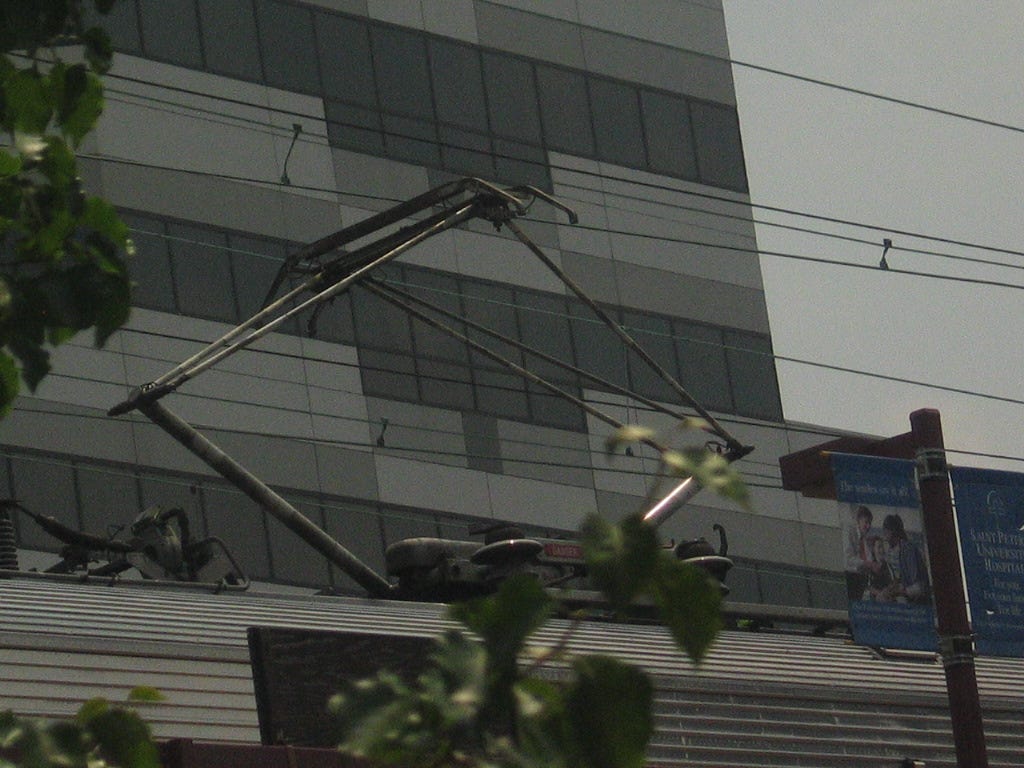
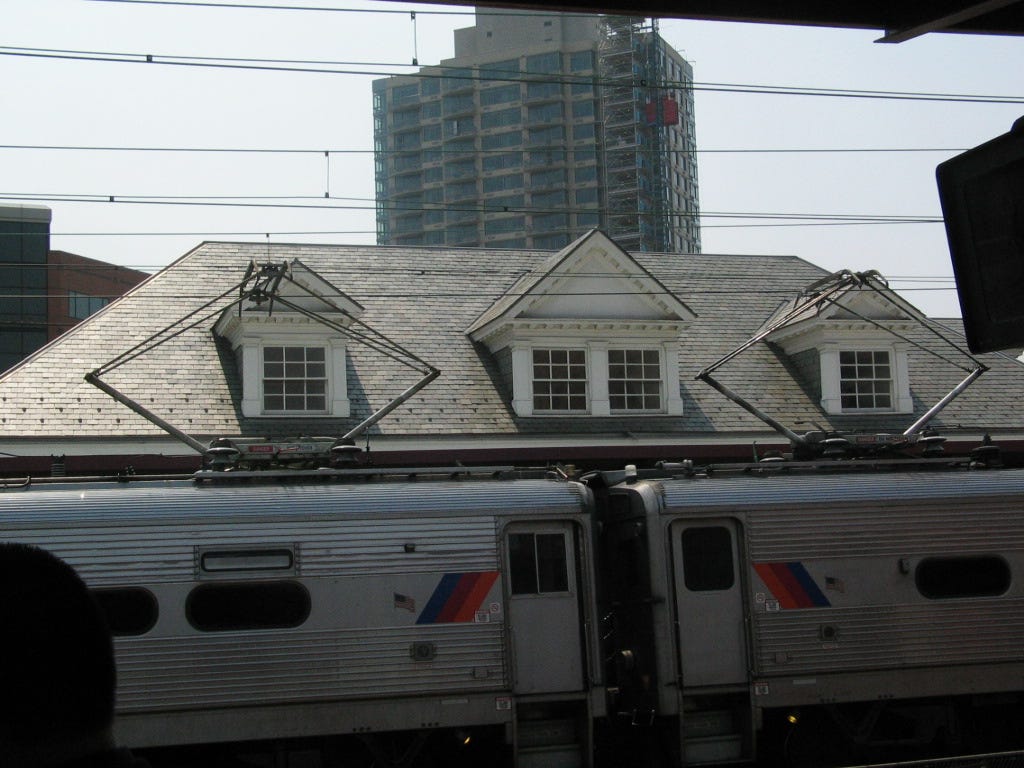
It begs the question whether this pantograph change has subtly interfered with horizontal stability of the pantograph or even changed the movement dynamics of the entire car due to change in weight and weight distribution.
Thought - Call to Amtrak and NJ Transit
Amtrak (and NJ Transit, where applicable) needs to standardize catenary incident reporting requirements and make sure that reports are accurate. Reports should include summaries as derived from CETC logs and radio logs to paint a better picture. Reports, especially when dealing with multi-pantograph Arrow III trainsets, should include pantograph configuration and report on which were damaged. We have no insights into secondary reports generated by Amtrak and NJ Transit so some portion of these ideas may already be standard.
The original cause for the penalty brake application on #3723 is not known. It is possible that the massive short circuit (assumed to be through the car body and the tracks) caused the cab signal pickup system to drop to restricting and apply the brakes. Given that the voltage dip at a minimum affected the 37 bus and 38 bus, covering 13 miles of territory, there is a good chance signal power as a whole was briefly affected. Signal power is also (indirectly) fed from the same 12kV transformers as catenary (trolley) power.
The 2024 report only referenced track 3 (occupied by #3947) losing power for an indefinite amount of time, despite #3862 losing power at Edison on track 1.
Crews need to report power losses immediately, no matter how trivial or temporary. It is not clear what #3723’s crew knew, but bear in mind that Arrow III trains do not have advanced pantograph monitoring like Acela and ACS-64 engines.
The cab footage and radio logs should be used as a demonstration to train crews of what can really happen and what damage looks like.
Thought - “bad batch” of pantographs
Some people have suggested NJ Transit received a “bad batch” of pantographs. Regarding this specific incident, given that this location has had two incidents in a 2 year period, it seems more likely that there is an architectural problem relating to rail alignment, pantograph mounts, pantograph pneumatics or catenary alignment rather than a problem with a specific material or batch of materials. Only the official diagnostic can rule that out if at all.
These were the dates printed on the pantograph mounts on #3723 that had damaged pantographs, starting from the front of the train:
6/23
8/21
12/21
11/23
Thought - “November” third party diagnostic report
In October 2024, it was announced in a political conference that there is an upcoming “diagnostic” report by a third party organized by Amtrak and NJ Transit regarding the many issues that took place around summer 2024. We hope it fills in gaps in this article. We eagerly await the report and plan to put out a response and commentary article.
This article was nearly completed at the end of November 2024. It is now the end of January 2025 and the diagnostic report is still not released yet. Accuracy and full collection of the necessary information is of course more important than any artificial deadline.
As of June 2025, it’s still not clear that this report was ever finished or even planned in the first place. The periodic Amtrak – NJ Transit joint updates (most recent one from April 15, 2025) only mention vague (though important) improvements.
Thought - Call to the public
Members of the public can help fill in missing details that Amtrak or NJ Transit neglect to record. Take pictures and write stories. You can assist researchers by documenting events like this one but preferably on platforms that are more compatible for historical research. Discussions on closed platforms may as well be thrown in the trash after everyone reads it the day it’s made.
This article would have been severely hindered had some of the materials been unreachable and unindexed on search engines and on platforms like Reddit and Wikimedia Commons. Wikimedia Commons was an excellent source of generic pictures of specific train equipment.
As a general rule, the more popular a platform is, the more likely it is to be inaccessible to non-participants or harder to search. This is a platform “tier” list ranking social media or message boards:
Great: forums (message boards) such as railroad.net, amtraktrains.com. These are easily visible to search engines and usually have search features that can sort by date. Forums also tend to be simple web pages making archiving easy.
Bad: Reddit - has a search feature but can’t sort by date. Until mid 2023, despite not having a full search feature, Reddit was actually a data goldmine because third parties could retrieve all content for free and there was a large ecosystem of third-party tools that worked with the data. Pre-2023 data is still around and there are still external tools that index Reddit content. Reddit is also now excluding search engines and has an exclusive indexing deal with Google.
Bad: Twitter / X - limited visibility among search engines, although individual tweets are still visible but fragile as it’s not a plain web page. Nitter instances (very few left) can help a lot in viewing Twitter as if you’re logged in but can break at any time if Twitter cracks down on the “rogue” services.
Bad: Facebook - May arbitrarily require log-in to view content. In practice, Facebook also has many private groups which are totally invisible to the internet. The Delayed on New Jersey Transit Support Group is an example group that is private and I seem to remember commuters talking about it over the years.
Awful: Discord - completely invisible to the internet. By design, every group is private though many have open invites.
Thought - Maps
OpenStreetMap data and its closely related tile services (main website and OpenRailwayMap) were wonderful tools for viewing map data. This section of the Northeast Corridor has extremely complete data.
OSM X-RAY is a nascent tool for viewing OSM’s raw data. It is quite unorthodox for use as a generated map but proved extremely useful in generating views of raw tagged nodes without any pregenerated labels.
OSM X-RAY code: https://github.com/joto/osm-xray
Demo: http://test.osm2pgsql.org
Thought - unused photos and videos from that day
The collections of unused photos and videos were uploaded in March 2025:
https://archive.org/details/northeast-corridor-metuchen-catenary-pantograph-damage-2024-04-15
https://archive.org/details/northeast-corridor-metuchen-catenary-pantograph-damage-2024-04-15-videos
Thought – NEC Commission narrative
The NEC Commission narrative for this event had been released in the annual report at the beginning of April 2025:
Total trains affected: 115
Total train-delay minutes: 6,182
Total trains not completed: 55
A train reported pantograph damage east of Lincoln Interlocking, followed by another train reporting extensive damage to its pantographs along with wires down on tracks 3 and 4. East- and westbound traffic was held until it was deemed safe to proceed. Track 1 was cleared for operations, allowing passenger transfers and removal of stranded trains. All eastbound traffic was fleeted to New York on track 1 and trains were delayed operating through the area. Power was returned to track 3. Due to late arrivals and crew shortages, further trains were canceled.
Thought - the video
A short form replay of the cab footage from the incident with radio audio embedded is planned to be released but not any time soon. The video will probably be the more popular piece of media from this project. It will be released under CC BY-SA (same license mentioned below) and can be reuploaded by anyone to any platform provided the license is followed.
Article changes
March 25th, 2025: Added “in the future” section, added links to unused photos and videos, added this section
July 1st-3rd, 2025: Clarified guess of penalty cause, added “NEC Commission narrative” details, removed “future” section, referenced the “catenary maintenance vehicle” by its actual number, specified Form D “drop pantograph” order timestamps, specified line 2 movement authority requirement under rule 251, clarified that the engineer of train #3169 correctly read back the Form D, noted lack of “diagnostic” report
Copyright
Disclaimer: Under Section 107 of the Copyright Act of 1976, allowance is made for purposes such as criticism, commentary, news reporting, teaching, education and research. This article contains both copyrighted and possibly public domain materials. Fair use exceptions apply. Please see notices attached to individual works for details. If attribution is not present, the work might be public domain or implicitly included as a first party work (“Livonius”) and part of this article.
Credit can be attributed to “Livonius” and a link to livonius.substack.com or this article is recommended.
This article is released under CC BY-SA (Attribution-ShareAlike 4.0 International): https://creativecommons.org/licenses/by-sa/4.0/









